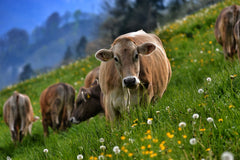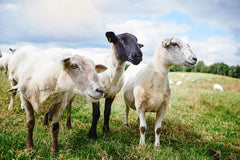
How Lactorite Helps Stress-Free Lactation in Dairy Cows
India is the world's top producer of milk. The Indian government intends to raise milk production by 23% annually. The various practical and affordable methods that can be used to increase milk production in India.
Dairy is the primary source of protein in India, where the majority of people are vegetarians. The nation is the world's most significant producer and consumer of dairy products, including paneer, ghee, yoghurt, and sauces made from milk. However, India's milk production is still far below international norms due to a combination of limited genetic potential, inadequate nutrition management, and a lack of veterinary support for its dairy cows.
The genetic potential of a cow or buffalo determines its milk output and fat proportion. Beyond its genetic capacity, milk output cannot be increased. However, the majority of dairy farmers in India do not even receive the full amount of milk that their cows may produce. The primary cause of severe malnutrition in dairy cattle is the numerous stressors to which they are subjected.
The easiest way to increase milk yield is to address both nutritional requirements and stress factors.
The Indian milk industry depends on healthy and stress-free cow milk production. In India, many farmers face difficulties maintaining the health of their cows during lactation, particularly in hot weather, due to sickness or nutritional stress. Use Lactorite, a homoeopathic veterinary preparation available in Goel Vet Pharma that is specifically intended to promote lactation in dairy cows. By using Lactorite on cattle, farmers will have a natural and safe method of helping to maintain normal milk flow, regulate hormone levels, and keep the udder healthy.
In this blog, we will explore how Lactorite works and compare it with conventional methods, and also provide guidance on how to raise cow milk using holistic methods.
Understanding Lactation in Cows
In India, lactation in cows typically begins immediately after calving and lasts for several months. This stage requires additional attention as cows are exposed to hormonal shifts, changes in nutrition, and stress. Healthy calves and proper management result in improved milk yield, better health, and increased income for the farmer.
However, low milk production is often caused by a poor diet, infections, and stress. The common question that farmers pose is, How to raise cow milk naturally? The solution is in a holistic treatment, such as Lactorite for cattle.
What is Lactorite?
Lactorite is a homoeopathic veterinary medicine that is used to enhance lactation in cows. Goel Vet Pharma is a natural, safe product that promotes milk production without any adverse side effects. The advantages of Lactrite to Cattle are as follows:
- Improves the production of milk.
- Regulates hormones in the lactation cycle.
- Prestablishes the pH of milk.
- Enhances the tonicity of the mammary glands.
- Safe, with no drug residues
On regular usage, Lactorite for cattle will provide a stress-free and constant milk flow during the lactation period of the cow in India.
Why Farmers Need Lactorite
Farmers in India often struggle with:
- Declining milk yield
- Stress during calving and lactation
- Nutritional deficiencies
- High treatment costs for synthetic drugs
By adding Lactorite to their cattle remedies, farmers find a cost-effective and safe solution. It works as a natural support system for lactation in dairy cows.
Lactorite vs Conventional Treatments
|
Feature |
Lactorite |
Conventional Treatments (Hormonal / Chemical) |
|
Nature / Type |
Homoeopathic veterinary medicine (natural remedy) — Lactorite for cattle |
Hormones, synthetic drugs, antibiotics, and growth promoters |
|
Residue in Milk / Safety for Consumption |
No harmful residues, safe for milk use |
Risk of drug residues, withdrawal periods required |
|
Side Effects |
Minimal or none, gentle on animal physiology |
Risk of side effects: hormonal imbalance, metabolic stress, udder infections |
|
Long-Term Use |
Suitable for prolonged use during lactation in cows |
Cannot be used long-term without risk of tolerance or side complications |
|
Effect on Animal Stress |
Supports stress-free lactation, balances hormones gently |
May cause stress or metabolic disturbances over time |
|
Ease of Administration |
Drops, easy to dose along with routine feed |
Injections, infusions, or complex dosing schedules |
|
Cost & Accessibility |
Affordable and accessible natural remedies in the cattle remedies product list |
Higher cost, dependency on veterinary supplies |
|
Compatibility with Other Treatments |
Can be safely combined with other remedies |
Possible drug interactions, contraindications |
|
Milk Yield Response |
Gradual, sustained improvement in the lactation period of cow in India |
Faster spike sometimes, but risk of abrupt drop later |
|
Consumer Perception |
Viewed as safe, residue-free, natural |
Seen with scepticism due to chemical residues |
How to Use Lactorite for Cattle
- Dosage: 5 ml, 3-4 times a day or as directed by a veterinarian.
- Apply directly to the tongue.
- Continue throughout the lactation stage of a cow in India to ensure a steady milk yield.
Lactarite is easy to use and effective, as farmers wonder how to increase milk production from their cows.
Benefits During the Lactation Period of the Cow in India
In India, the lactation duration of cows differs with breed and management. Cows require as much support as possible in terms of nutrition and medicine during this time. Lactorite available to cattle guarantees:
- Increased milk quality and even pH.
- Stronger mammary glands
- Less stress following calving.
- Improved overall health
This renders Lactorite a necessity on the list of cattle remedies for all farmers.
The Role of Lactorite in Lactation in Dairy Cows
To ensure sustainable dairy farming, lactation in dairy cows should be managed. Lactorite addresses:
- Hormonal imbalances
- Reduced yield due to stress
- Weak mammary functions
It facilitates the smooth transition of cows to lactation, allowing them to produce milk stress-free. Cattle farmers who have been using Lactrite have been reporting a substantial increase in milk quantity and quality.
How to Increase Cow Milk with Natural Remedies

Farmers are often seeking ways to increase milk production from cows without relying on expensive feed. Here are the steps:
- Prepare clean water and well-balanced feed.
- Keep cattle sheds clean.
- Provide exercise and rest.
- Naturally, add Lacterite to the routine.
The combination of effective management and Lactrite will help improve lactation in cows.
Other Helpful Products from Goel Vet Pharma
Farmers can also learn about more of the cattle remedies product line:
- Marigold+ LSD-25 Kit lumpy skin disease.
- Liver Up for Cattle promotes liver health and digestion.
- Cerapet enhances bone strength and calcium uptake.
This, together with Lactorite to treat cattle, makes the herd healthier and more productive.
Why Choose Goel Vet Pharma
Goel Vet Pharma has established a reputation in India for providing effective and safe homoeopathic remedies. Their products:
- Treat diseases such as mastitis in dairy cows, skin diseases, and immune system problems.
- Offer affordable solutions
- Free of noxious residues.
- Adapted to the Indian farming conditions.
Goel Vet Pharma is the brand of choice for farmers seeking a genuine list of cattle remedies.
Conclusion
In India, dairy farming depends on the healthy lactation of cows. Factors such as stress, improper diet, and hormonal imbalance influence the lactation of cows in India, resulting in decreased milk production. Lactate as a cattle feed provides farmers with a natural, safe and effective option.
Incorporating Lactorite into their daily herd management, farmers not only respond to the question of how to make cows produce more milk but also provide long-term productivity. In addition to other cattle remedies, the product list items of Goel Vet Pharma ensure a healthier and happier cow, as well as stress-free farming.
- Support lactation with ease now.
- Buy Lactorite for Cattle – 30 ml.
- Reliable Goel Vet Pharma to provide safe and effective solutions to the lactation diet in dairy cows.








